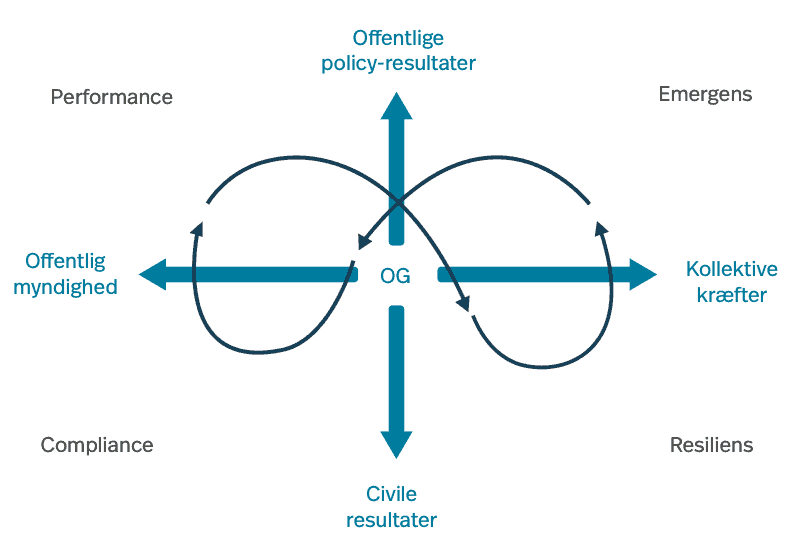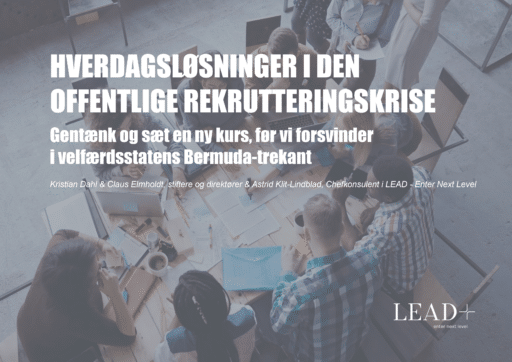This article introduces a new research-based approach to strategically positioning and leading public organizations in the creation of well-being.
In 2006, Jocelyne Bourgon(2) began a now almost 10-year research project that has involved over 200 senior executives, politicians and researchers from Australia, Canada, the Netherlands, England, Brazil, Singapore and New Zealand, among others. The research question was big, but simple:
- How do we manage the public sector so that we can continue to deliver the same or better welfare in a time of fewer resources, increasing demands and complexity?
Together with Jocelyne Bourgon, we are working during 2016 and 2017 to explore this important question in a Danish public context. The goal is to develop a strategic framework model that, based on international and national perspectives, provides top managers and their politicians with clear and perhaps new opportunities to make strategic choices and set direction. Below is a brief presentation of the most important conclusions from the project so far.
Stay on top of things and get more for less
Participants initially identified two well-known focus areas as essential:
- Staying on top of things - Compliance: The first thing the participants pointed out was that leaders and politicians in the public sector have a classic, but crucial task in ensuring continued mastery of the classic virtues of public servants. It makes no sense to talk about innovation or other more popular management concepts if you don't have your own and others' house in order. In a Danish context, the Bo Smith Committee's work on the seven key duties for civil servants in central administration is a good example of this. Furthermore, participants pointed out that it was crucial to maintain and develop the public sector's ability to ensure compliance with the law in society through the exercise of authority. In line with this, implementation also becomes a key theme.
- More for less - Performance: Next, the participants pointed out the crucial importance of having a continuous focus on optimizing and streamlining the way the public sector meets political ambitions. Here, work is typically done with slightly different angles: A) A management and savings logic where you set key goals for the organization, reduce the budget and let the organization adapt between these two, B) A production optimization logic often inspired by LEAN and C) A professional evidence strategy where you "de-privatize" the space of the professionals and try to ensure that the professional, based on a common standard, does what works best professionally in the core service. However, an important point was that internationally, public organizations were often measured on too narrow organizational goals and thus unintentionally stimulated the production of solutions that ignored broad societal needs.
These conclusions are not surprising and in many ways represent our familiar reactions when it comes to developing the public sector: it has to be cheaper and more efficient! And we must make sure the rules are followed - otherwise things will fall apart! In recent years, the debate on public management has to some extent highlighted the above as contradictions, or as going from classical management to NPM. However, an important point from the participants in the research project was that it is crucial that both perspectives are mastered and that management is able to work in parallel and in a balanced way. Furthermore, it was a key point that a one-sided focus on one of the two often results in problems.
The four focus areas of the New Synthesis:

READ MORE ABOUT OUR EDUCATION
LEAD
offers certification in the development of agile leadership with the development tool The Leader's Versatility Index (LVI)
With a certification, you will be equipped to use LVI in development processes in your organization at the individual, group and organizational level.
Innovative welfare with others, resilience and robustness At the same time, the participants also painted a picture that a focus on Performance and Compliance was not enough. Across the participating countries in the project, there was a broad consensus that more is needed. The conclusion was that the challenges facing our society are so complex and resource-intensive that we must seek to supplement the traditional regulatory approach with new ways. Or to put it more succinctly: Government patenting of societal problems and their solutions is insufficient. As a government, we must find ways to enable others to contribute to solving complex problems, and we must also ensure that it is possible for a wide range of actors to create welfare. Participants identified two strategic options for public sector leaders and their politicians to navigate:
- Innovating welfare together with others - Emergence: This has two dimensions. Firstly, participants pointed to the crucial importance of the public sector developing platforms and spaces for civil society to become co-producers of welfare. The Heart Runner concept is a good example. Heart runners are citizens who are registered with the emergency response centers via Trygfonden. When the emergency call center receives an emergency call reporting a cardiac arrest and there is no ambulance in the immediate vicinity, a text message is sent to the heart runner, who runs to the nearest defibrillator and brings it to the person in cardiac arrest. In terms of control, the big question here is: How do we make others producers or co-producers of welfare? How can we get people other than ourselves to contribute here? Or deliver what we do - perhaps just in a different way? Likewise, the participants in the research project pointed out that it became crucial to strengthen the public sector's ability to broadly involve several different parties in the co-creation of public policy and strategy. Furthermore, participants pointed to the crucial importance of continuing to strive for innovation and increasing our ability to discover and successfully apply new solutions and technologies that will often be developed outside of the public sector.
- Resilience and robustness - Resilience: Across the participating countries, a picture emerged that the continued well-being of societies was increasingly dependent on their ability to learn to adapt to new situations and deal with crises, disasters and unforeseen societal movements. The essential question for top leaders and politicians is this: How can we strengthen society's ability to manage and recover from significant crises and challenges? How do we strengthen society's ability to adapt to change? Resilience is typically approached from a number of different professional angles. From a psychological perspective, the focus is on how people's ability to overcome stresses and risk factors in life can be strengthened. From a political science angle, the focus is typically on how to ensure flexibility and adaptability in society.
From an environmental and climate perspective, work is typically done on how cities can be geared to handle increased population growth while dealing with an often more extreme climate and increased expectations for energy efficiency improvements. Vejle's participation in the Rockefeller Foundation's 100 Resilience Cities network, where 100 cities will develop and implement resilience plans, is an example of this. From an emergency preparedness perspective, the focus is typically on building capacity to handle extraordinary events and disasters. In a Danish context, the Utøya attack was the tragic catalyst for the development of police preparedness, which was put to the test with the terrorist attacks on Krudttønden and the Jewish synagogue.
The new synthesis for public welfare creation
Taken together, the four strategic domains provide a solid framework that public sector leaders and policy makers can use to guide reform creation and strategic development of the public sector.
A simple and quick way to start working on thinking can start with the questions below:
- What are my organization's strengths and weaknesses based on the New Synthesis model? What are the short and long term consequences?
Based on the above perspective, the following questions will also be of deep strategic relevance:
- How can we find solutions to our key challenges through a management balancing act between Compliance, Performance, Emergence and Resilience? What does this require from our organization in terms of leadership?
On a more personal management level, the model describes some of the requirements that are already indispensable for most public sector top managers: You must ensure compliance in your organization and you must master the development of your organization's performance. The indispensability of these basic requirements is emphasized by the fact that most people will be able to name one or more Danish public sector top executives who have lost their jobs in recent years by failing on one of these basic requirements. The basic requirements of the Emergence and Resilience fields, on the other hand, have been far less important to most top executives - and few can point to top executives who have been fired due to a lack of innovation or co-creation. This does not mean that the fields are unimportant, but that they may not have been a crucial part of the strategic space for creating policy, reforms and positioning public solutions to complex societal problems. The New Synthesisresearch project suggests that this will become an increasing requirement in the future for two reasons:
- Declining public budgets, but increased political pressure to maintain or develop existing service levels.Increasing societal complexity and an increase in the amount of complex societal issues that cannot be solved by the public sector alone.The public sector leader who only works with Compliance and Performance will simply have too narrow a strategic maneuvering space to handle these challenges over time. The public sector leader who also works with Emergence and Resilience will be able to generate more room for maneuver when interacting with politicians. On a broader level, this also implies a significant evolution in the way the public organization as well as policy understands citizens and their role.
In this context, citizens are more than users or beneficiaries of government services: They are value creaters. An increasing number of public policy results can only be created by government and society working in synergy (Bourgon, 2011, p 200)
Rounding up
- Ensure all four strategic options are on the table in policy processes to stimulate new and better solutions.
- Be aware that "forgetting" the classic virtues or optimization logic can be disastrous.
- Be aware that the classical virtues or optimization logic are not enough and will only create more of the same or an optimized version of it.




